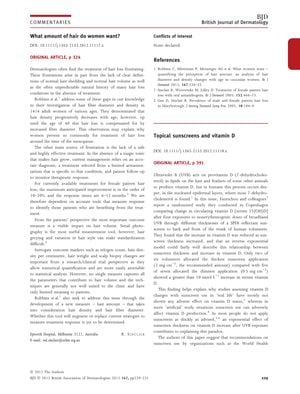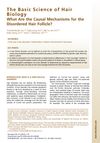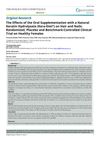Topical Sunscreens and Vitamin D
July 2012
in “
British Journal of Dermatology
”

TLDR Hair loss treatments show limited improvement, sunscreen thickness affects vitamin D production, and the effectiveness of IVIg for toxic epidermal necrolysis is uncertain.
The document discusses the challenges dermatologists face in treating hair loss, particularly due to the lack of clear definitions for normal hair shedding and volume, and the unpredictable nature of hair loss conditions. Robbins et al. conducted a study with 1414 adult women and found that hair density decreases with age, but until age 40, this is compensated by increased hair fiber diameter. This could explain why hair loss treatment is commonly sought around menopause. The document also highlights the limitations of current hair loss treatments, which only offer a 10-20% improvement over 6-12 months, and the need for accurate tools to measure treatment response, such as serial photography and surrogate outcome markers. Robbins et al. developed a new measure that considers both hair density and fiber diameter, but it is unclear if this will replace current methods.
The document also reviews a study by Faurschou and colleagues on the effect of sunscreen thickness on vitamin D production after UVB exposure. The study found that vitamin D increase was inversely related to sunscreen thickness, with those applying the thickest recommended amount showing less increase in vitamin D. This suggests that the lack of adverse effects on vitamin D status in real-life studies of sunscreen use may be due to people not applying sunscreen as thickly as recommended. The paper calls for a re-evaluation of sunscreen use recommendations, considering the balance between skin cancer prevention and potential vitamin D deficiency risks.
Lastly, the document touches on the management of toxic epidermal necrolysis (TEN) and the controversial role of intravenous immunoglobulin (IVIg) in its treatment. Despite initial positive reports, recent meta-analyses, including one by Huang et al., have cast doubt on the efficacy of IVIg for TEN, as no controlled trials have been conducted and existing studies lack homogeneity. The document suggests that improvements in supportive care may also confound the perceived benefits of IVIg in treating TEN.




